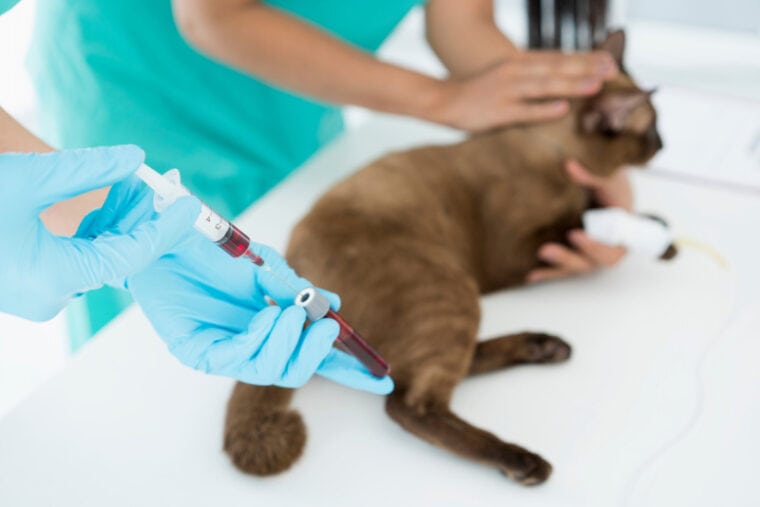
Click to Skip Ahead
Cats can have an allergic reaction to numerous allergens, including insect bites or stings, medications, foods, and environmental substances (e.g., mold, pollen, grass, and dust mites).
Pet owners should be familiar with the different clinical signs of allergic reactions in animals and take their cats to the vet if they are concerned. Your vet will perform or order allergy tests to find out which allergens your cat is sensitive to and administer the appropriate treatment.

How Does Allergy Testing in Cats Work?
Allergies are exaggerated reactions of the body as a result of coming into contact with certain substances in the environment. The immune system of cats prone to allergies treats these substances as foreign (non-self), so it acts against them, triggering an immune response.

Allergies have unpleasant manifestations and can affect your cat’s daily activities and mood. The most common allergens in cats are flea saliva, dust mites, pollen, and mold. Cats can also develop food allergies, but this is not as common for cats as it is for dogs.
Before the veterinarian performs or orders allergy tests for your cat, they will evaluate them thoroughly to eliminate other causes that may have common clinical signs. If the vet suspects an allergy, they will then recommend allergy tests.
Allergy testing involves skin (intradermal) testing or hematological (blood) testing to discover whether a substance or allergen triggers an allergic reaction in your cat.
In the case of food allergies, there are no specific tests that can be performed, but the veterinarian can recommend an elimination diet trial, where you will remove a food that your cat regularly consumes and gradually reintroduce it, observing if the clinical signs of an allergy occur. For this type of allergy, blood tests can give unreliable results and are considered inadequate.

What Are the Different Types of Allergy Testing?
If your cat shows clinical signs indicating an environmental allergy, the vet may recommend an allergy test (hematological and/or intradermal).
1. Allergy Blood Tests

Allergy blood tests involve collecting a blood sample from your cat and sending it to a laboratory for analysis. The blood is then studied for various antibodies that are formed in the presence of allergens. In other words, the blood test checks for the specific antibodies (IgE) that indicate your cat’s hypersensitivity to a particular allergen.
This method of analyzing your cat’s blood is generally easy to perform and convenient for you (the owner), especially since a specialist veterinarian is not needed to collect the blood sample and analyze the results. Cats do not need to be sedated; the sample can be collected in just a few seconds.
Allergy blood tests do have certain limitations. For one thing, there are often false positive or false negative results, along with differences between the results of subcutaneous allergy testing and blood analysis.
Feline IgE ELISA Assay
The most used allergy blood test is the immunoenzymatic technique for titration, called enzyme-linked immunosorbent assay (ELISA). This test measures the level of the antibody IgE in the blood, which is produced by the body in response to various antigens, causing the allergic reaction.
Radioallergosorbent Test (RAST)
The RAST test looks for specific antibodies associated with allergies to identify the triggers in your cat. The test detects the IgE levels, as it is mainly used to diagnose environmental allergies (inhalant allergies or atopy, a condition that causes skin redness and itching), and it is not effective in diagnosing contact or food allergies. The blood sample is sent to a laboratory for testing, and the results may be ready in 1–2 weeks.
This allergy test was created for humans, so it can give false positive results when used in cats. For this reason, veterinarians also recommend intradermal testing concomitant with the RAST test.
2. Intradermal Testing

Allergy skin tests are preferred to blood tests because they are performed faster and are more conclusive. However, diagnosing allergies in cats by intradermal testing has an accuracy of only about 80%.
Intradermal testing involves injecting a small number of allergens under your cat’s skin. The procedure is generally performed under general anesthesia and consists of 40–60 injections in a single area of the body, each containing a small sample of different allergens.
Before the test, your cat’s hair will be shaved, and the skin will be disinfected. If your cat’s skin begins to swell in the area of an injection in the first 20 minutes after its administration, this is a positive reaction, thus identifying the allergen that causes the adverse reaction. If no sign of irritation occurs, it can be assumed that your cat is not allergic to that allergen.
Although intradermal testing is the most frequently used method of detecting the various allergies that pets can suffer from, it has certain restrictions.
3. Testing for Food Allergies

In the case of a food allergy, your cat’s immune system misinterprets a certain protein in their diet, perceiving it as an enemy. It triggers an immune response that can cause discomfort and distress to your pet.
The only effective method of diagnosing food allergies is a strict diet (on the recommendation of the veterinarian) that contains only one type of protein, along with vitamins and minerals. This will be the sole source of food for your cart for a period of a month or more; afterward, your cat’s regular diet can be reintroduced.
If your cat’s condition improves during the elimination trial diet but worsens considerably after the reintroduction of the regular diet, they likely have a food allergy. But to identify the allergen, it is necessary to reintroduce your cat to the trial diet and add the ingredients from your cat’s regular diet one by one, documenting the reaction of your cat’s body to each individual component.
Another method of treating food allergies is feeding them a hypoallergenic diet, where the protein molecules are broken down to small sizes so your cat’s immune system does not recognize them. However, there is no such thing as a hypoallergenic food diet in the true sense of the word, though some pet food manufacturers offer such a variant. There is also no evidence that changing the diet regularly or feeding protein from duck, venison, or rabbit can improve the health of pets with food allergies.

Frequently Asked Questions (FAQs)
What Is the Difference Between ELISA and RAST Allergy Tests?
Although both tests are performed on the blood and can determine whether your cat is allergic to a certain substance, there are a few slight differences between them. The ELISA test measures the number of allergen-specific antibodies, while the RAST test detects specific allergen-related antibodies.
What Are the Clinical Signs of Allergies in Cats?
The main clinical sign of allergies is itching. In the case of flea allergies, it mainly affects the back half of the body, the hind legs, and the base of the tail. In addition to intense scratching, cats can present hot spots, hair loss, watery eyes, ear infections, and gastrointestinal problems. If your cat’s allergy goes untreated, secondary bacterial and fungal infections can develop on the skin due to intense scratching. In severe cases, cats’ faces may swell, and they may have difficulty breathing.

How Are Allergies in Cats Treated?
To effectively treat cat allergies, find out which allergen your pet is sensitive to. If you do not want to perform allergy tests, you can apply antiparasitic substances on your cat regularly, clean and treat the environment, or change their diet. If your cat seems itchy and scratches excessively, the vet can prescribe antihistamines or corticosteroids. These drugs are not as effective for food allergies as they are for environmental allergies or atopy.

In Conclusion
If your cat suffers from environmental allergies, the veterinarian can recommend allergy tests (blood or intradermal) to determine the allergen responsible for your pet’s reaction. Depending on the test that you choose or what the vet recommends, the results can be immediate or you’ll have to wait up to 2 weeks.
Treating allergies is often difficult because not all cats will respond favorably to treatment. However, testing your cat is necessary for determining the “culprit” and recommending the appropriate treatment, though allergy tests are not 100% accurate. If your cat suffers from food allergies, your vet will recommend changing their diet to one that has a unique protein. After your pet’s clinical signs have resolved, your vet may recommend reintroducing your cat to their usual diet to see if they develop any reactions again.
Featured Image Credit: thirawatana phaisalratana, Shutterstock







